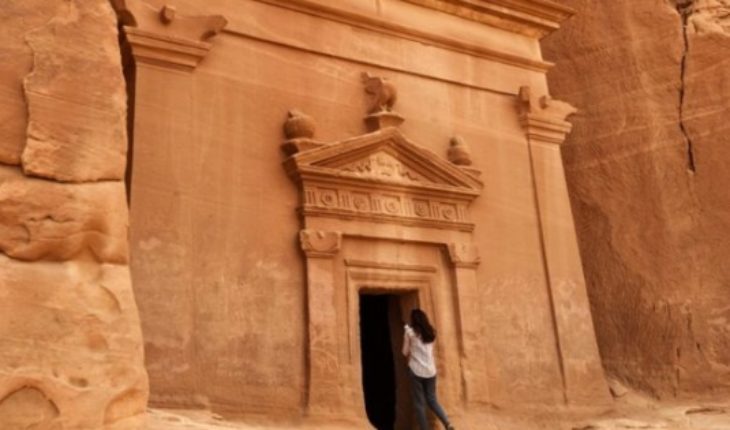Saudi Arabia’s recent decision to open its doors to foreign tourists has provoked a first surge of excitement in the travel industry.
A vast country and so far largely closed to the world is now there to be discovered. What’s there to see in Saudi Arabia? Why go?
Saudi Arabia will allow for the first time the entry of tourists, but only some countries
It is not an economic destination like Southeast Asia, it is scorching for eight months of the year, there is no political or expression freedom, nor is alcohol allowed.
There is almost no men and women on the streets and, like many other countries in the Middle East, has a highly criticized history of respect for human rights.
That said, Saudi Arabia is much more diverse in landscapes and scenarios than you can imagine.
Indeed, most of the country is desert, but then there are the high mountains of 3,000 meters high of Asir in the southwest, covered with juniper; or the blue reefs of the Red Sea; also the oasis of palm trees of al Hofuf; and the sinuous streets and spice markets of Jeddah.
Pictured: The highlights of Saudi Arabia that will now be able to visit tourists from 49 countries
I have been fortunate to travel much of the country since the late 1980s.
The Saudis often joke that I’ve seen more of their country than they do, so here’s a list of my favorite places to visit.
Jeddah
This smoldering Red Sea trading port was the capital until 1982, when it moved to Riyadh.
Jeddah today is a captivating and culturally rich melting pot where every race of the Red Sea is represented.
Saudi women run through the old Balad neighborhood of Jeddah.Es a perennially warm, outdoor city, where Egyptians sit at coffee tables, smoking water pipes and playing backgammon under street lights.
Yemeni tailors squat cross-legged in clothing stores where they work late at night, while Somali, Eritrean and Djibouti women display their spice samples in the street market.
In the winding cobblestone alleyways of the old district, known as Balad, it is not uncommon to hear the language of the Ethiopian highlands mingling with Arabic and Hindi.
Traditional houses are being restored in the Balad district of Jeddah. Jeddah is also the gateway to Mecca and Medina for the more than two million Muslims who make the pilgrimage to the Hajj each year.
The country that wants to become the new Mecca
Further up the coast are beach resorts and dive sites, although many of the coral reefs on the high seas have disappeared in recent years.
The Asir Mountains
There are expats who have lived in Saudi Arabia for more than a decade without ever having visited this jewel in the far southwest of the country, next to Yemen.
“You could tell he could do whatever he wanted”: how did a 34-year-old prince become the most powerful man in the Middle East?
They’re missing a present.
In the misty mountains of Asir, paragliding and rock climbing are beginning. The landscape can be lush and green, even in the middle of summer, and I’ve even seen a juniper forest turn white after a sudden hail storm.
An estimated 500,000 Hamadryas baboons inhabit the mountains, along with slugs, eagles and dazzling blue agamid lizards.
The landscape is full of basaltic stone watchtowers, a legacy of tribal struggle that used to take place there a century ago.
In recent years, the region has opened to national tourism, with a cable car descending from the heights to a picturesque village called Rijal al Ma’.
The village of Rijal Al-Ma’ is reached by cable car from the top of the mountain. In a canyon called Wadi Habala, named after the rope that used to lower supplies down the cliff to the villagers living on its slopes, there are breathtaking views over the misty mountains that descend into the Red Sea.
Mada’in Saleh
The ancient Nabataean ruins in the far northwest of the country are notable, not only for their preserved sculptures reminiscent of Petra (Jordan), but also for their beautiful desert setting.
The Hijaz, the historic western edge of the Arabian Peninsula, is where TE Lawrence fought the Turkish army in the 1917 Arab revolt and where you can still see the remains of the old Hijaz railway.
The tomb of Qasr al-Farid in Madain Saleh is also a Unesco world heritage site.For years, the Saudi authorities kept silent about Mada’in Saleh, as religious fundamentalists were less interested in promoting something that dates back to a pre-Islamic civilization, known in Arabic as “the age of ignorance.”
Under the new tourism promotion scheme, the site will be on the map.
Al Hofuf
The Hofuf’s oasis of date palms covers a vast area of eastern Saudi Arabia, said to be the largest of its kind in the world and creating a lush green world of streams and gardens.
But the truly spectacular attraction here is the system of ghostly caves within the Al Qarah mountain, registered in 2018 as a Unesco cultural heritage.
The caves on the Qarah mountain offer a respite from the outside heat. Natural caves, carved by wind and water erosion, require a bit of climbing to enter, but worth the effort.
Especially since they are significantly cooler than the heat outside.
A warning
The Saudis, for the most part, welcome foreign visitors, but this new opening is not without risks.
Where very different civilizations come into contact there is always the possibility of a misunderstanding or some offense.
Women should never be photographed in public, for men can fiercely protect the modesty of their wives.
Saudi Arabia’s society remains deeply conservative, but they do not disdain visitors. Outside the major cities of Riyadh, Jeddah and the Eastern Province, many people have never had contact with Westerners and can be wary, especially when cameras and phones are taken out.
So you have to be careful where to point and always ask permission.
translated from Spanish: Tourism in Saudi Arabia: what the mysterious country that is opening up to foreigners offers
October 28, 2019 |





